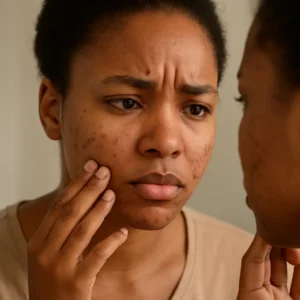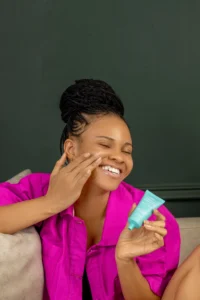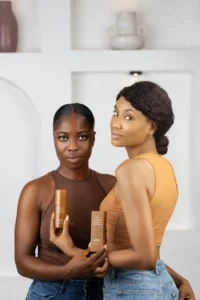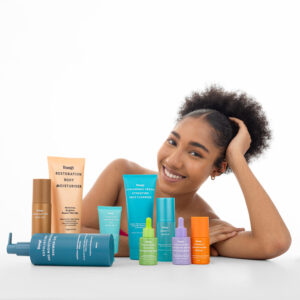
Free Shipping on Orders Over N200,0000 within Lagos
Buy 300k and get 20% off any spa service
Free Shipping For Orders over $150
Free Shipping For Orders over £100
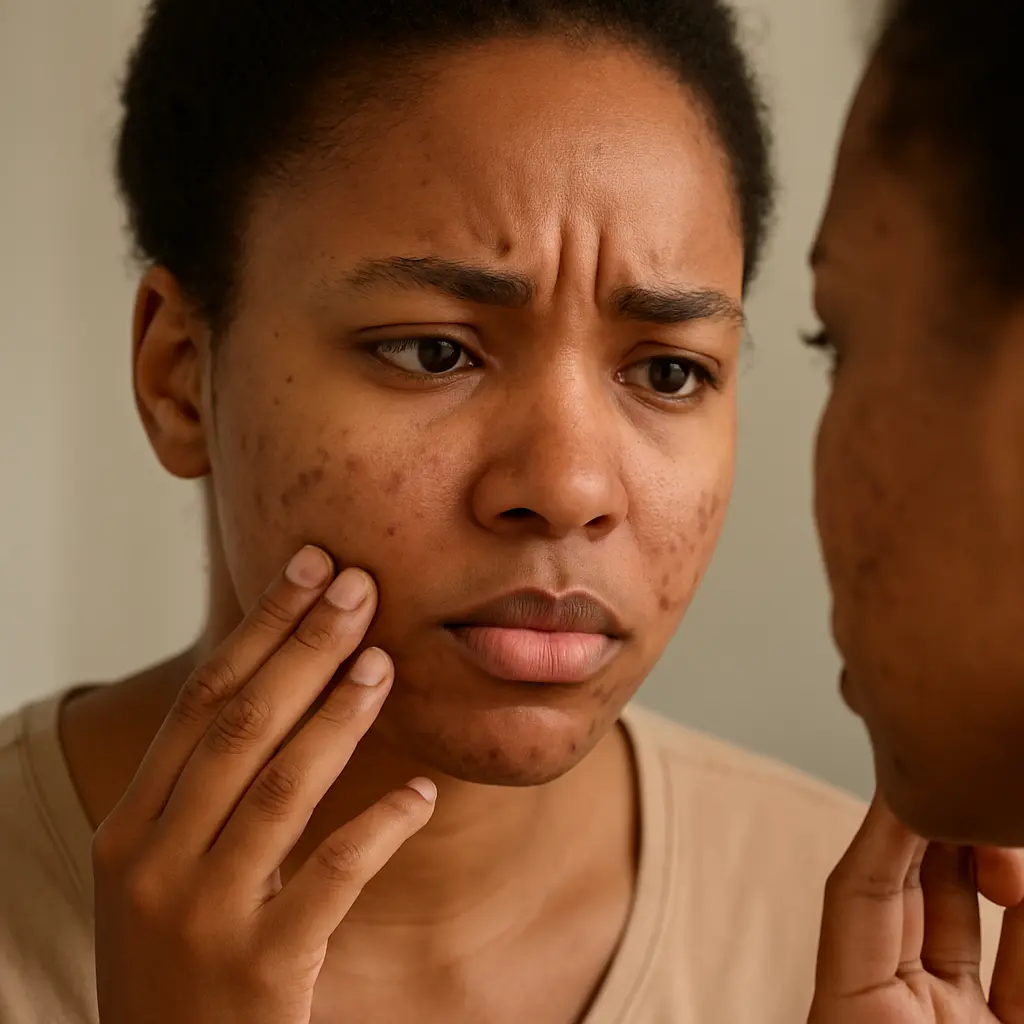
Let’s talk about how to build a skincare routine for acne-prone skin.
Acne is more than just a few pimples that show up before an important event. For people of colour, it often comes with an added layer of frustration: dark spots, uneven tone, and scars that linger long after the breakout has healed.
If you’ve ever wondered why acne seems harder to manage on melanin-rich skin or how to build a skincare routine that clears the dark spots and protects your glow, you’re in the right place.
As a melanin-rich skincare-focused brand dealing with skin of colour concerns like acne, hyperpigmentation, textured skin, among others, for over 4 years, we’ll walk you through how to create a skincare routine for acne-prone skin.
You’ll discover the skincare products and routine that treat breakouts and protect your skin from long-term damage.
Let’s start at the root.
The best skincare routine for acne-prone skin, especially melanin-rich skin, focuses on clearing breakouts while preventing dark spots and long-term damage. Start with a gentle, non-stripping cleanser, follow with targeted serums like niacinamide, azelaic acid, or retinoids, then lock in moisture with a lightweight, barrier-supporting moisturizer.
Always finish with a broad-spectrum sunscreen (SPF50) in the morning to protect healing skin and prevent hyperpigmentation. Add gentle exfoliation 1-2 times a week and consider professional treatments for severe acne or stubborn marks.
Consistency and products formulated for skin of colour are key to achieving clearer, brighter, and healthier-looking skin.
Acne occurs when your pores become clogged with excess oil (sebum), dead skin cells, and bacteria. For people of colour (Fitzpatrick III–VI), inflammation often triggers melanin overproduction.
Indeed, acne-induced PIH occurs in about 65 % of African-American, 53 % of Hispanic, and 47 % of Asian patients, leading to dark marks even after acne heals.
The culprits?
Not all acne is the same, which means not all acne responds to the same solution. Here’s a quick breakdown:
Pro tip: No matter the type of acne, the wrong products (too harsh or too drying) can make acne worse on melanin-rich skin. This is why you should work with an esthetician for tailored solutions.
Here’s the step-by-step guide that balances acne control with protection against PIH:
Use a gentle, non-stripping cleanser that removes excess oil and dirt without disrupting the skin barrier. Look for ingredients like mandelic acid (to clear pores) or niacinamide (to calm inflammation).
Pro Tip: Avoid harsh soaps, as they can cause dryness and trigger even more oil production.
Explore Dang! Mandelic Acid 3-in-1 Foaming Face Wash for exfoliating.
Alcohol-free toners with soothing agents (like witch hazel, aloe vera extract, green tea extract, or rose water) help balance the skin and prep it for treatments.
Explore Dang! Beauty Water (Alcohol-free Toner).
This is where the skincare actives work their magic.
Explore the Dang! Acne treatment, brightening, and hydrating products like Niacinamide, Azelaic Acid, Vitamin C concentrated serum, collagen, and hydrating serum with ceramides.
Choose lightweight, oil-free, lightweight moisturisers. Ingredients like ceramides, niacinamide, and aloe vera are excellent for soothing melanin-rich skin.
Explore the Dang! Ceramides Buffet Day Cream
SPF 50 broad-spectrum sunscreen is non-negotiable. For melanin-rich skin, look for invisible gel formulas or sunscreens with no white cast.
Sunscreen prevents dark spots from getting darker and protects healing skin.
Explore the Dang! Hydra Glow Sun Protection Gel (100% clear/transparent sunscreen)
For stubborn or severe acne, it’s best to seek professional care. Options include:
Always consult a licensed dermatologist or esthetician familiar with your skin’s needs when dealing with severe acne.
That’s why choosing products that are effective yet gentle and formulated with skin of colour in mind is the best long-term solution.
Choosing the right products means choosing a skincare brand with proven results.
With customer reviews and testimonies of transformed lives, Dang! Lifestyle is the Best Skincare Brand in Nigeria (available also in the US/UK/Canada) you can trust for your Melanin-Rich Skin needs.
At Dang! Lifestyle, our formulations are made with melanin-skin (people of colour) in mind, dermatologist-backed, safe, and proven to deliver results without compromising your natural tone.
Here’s our recommended acne-prone skin care routine:
These steps together form a complete routine that clears breakouts, fades dark spots, and restores your skin’s balance.
Shop our skincare treatments for acne.
Managing acne on melanin-rich skin isn’t just about fighting pimples. It’s about protecting your skin barrier, preventing dark spots, and building a consistent routine that supports long-term skin health.
Clear and radiant skin is possible with the right products, the right knowledge, and a little patience.
Vitamin C isn’t a direct acne treatment, but it helps reduce inflammation, fade dark spots (post-acne hyperpigmentation), and support skin healing. It’s best used alongside acne treatments, not as a replacement.
Retinol is more effective for treating active acne because it increases cell turnover, unclogs pores, and prevents new breakouts. Vitamin C is better for addressing acne spots and overall skin brightness. Many routines use both, but not at the same time of day. It’s best to use Vitamin C in the morning and retinol at night.
Look for serums with ingredients like salicylic acid, niacinamide, or retinol. These directly target breakouts and excess oil. For fading acne spots, vitamin C or azelaic acid serums are excellent. The “best” depends on whether your priority is stopping breakouts or fading dark spots.
Both are great, but they serve different purposes:
You don’t have to choose between them. You can use both, either in the same routine (if your skin tolerates it) or at different times of day. See more details on how to use niacinamide and vitamin C.
Niacinamide serums are the top choice for oily skin because they balance sebum production and reduce shine.


